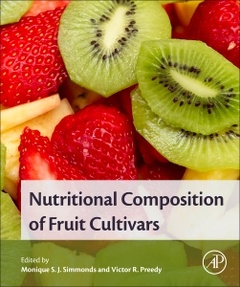Description
Nutritional Composition of Fruit Cultivars
Language: English
Subject for Nutritional Composition of Fruit Cultivars:
Keywords
Actinidia arguta; Actinidia chinensis; Actinidia deliciosa; Alkaloids; Amino acids; Annona squamosa; Annona squamosa�Annona cherimola hybrid; Anthocyanins; Antioxidant activity; Antioxidant capacity; Antioxidant compounds; Antioxidant; Antioxidants; Arils; Aroma composition; Aroma compounds; Aroma; Artocarpus heterophylus; Ascorbic acid; Balanites aegyptiaca Del.Date palm; Banana; Betalains; Bilberry; Bioactive compounds; Bioactivity; Biological activity; Black currant; Cactaceae; Cactus; Carb
796 p. · 19x23.3 cm · Paperback
Description
/li>Contents
/li>Readership
/li>Biography
/li>Comment
/li>
Nutritional Composition of Fruit Cultivars provides readers with the latest information on the health related properties of foods, making the documentation of the nutritive value of historical cultivars especially urgent, especially before they are lost and can't be effectively compared to modern cultivars.
Because there is considerable diversity and a substantial body of the compositional studies directed towards commercial varieties, this information is useful for identifying traits and features that may be transposed from one variety to another.
In addition, compositional and sensory features may also be used for commercialization and to characterize adulteration. Detailed characterization of cultivars can be used to identify "super-foods". Alternatively, unmasked historical cultivars may be the focus of reinvigorated commercial practices.
Each chapter in this book has sections on the botanical aspects, the composition of traditional or ancient cultivars, the composition of modern cultivars, a focus on areas of research, the specialty of the communicating author of each chapter, and summary points.
Fruits from Avocado to Tangerine, each entry featuring coverage of:
- Botanical aspects
- Composition of Traditional Cultivars
- Composition of Modern Cultivars
- Focused Research Information
Summary points
Agriculturalists, Food scientists, food technologist, food industry workers from harvest to production and packaging. Also nutritionists interested in understanding dietary value differences
Website: www.plantcultures.org.uk
Position:Director of Kew Innovation Unit, Deputy Keeper & Head of Sustainable Uses of Plants Group, Jodrell Laboratory, Royal Botanic Gardens, Kew, Richmond, Surrey, UK.
Qualifications and appointments:
•BSc (Hons), Univ. Leeds
•PhD, Birkbeck College, Univ. London
•Fellow Royal Society of Entomology
•Fellow World Innovation Foundation
•Fellow of the Society of Biology
•Fellow of the Linnean Society
•Member of the College of Medicine
•Member of Darwin Initiative Advisory Committee
•Member of Science Advisory Board for the Forestry Commission
•Member of Scientific Advisor Board for International Foundation of Science
•Elected Director of the Association of Good Practise in traditional Chinese medicine
•Editor-in-Chief, Biochemical Systematics and Ecology
•Editorial Board, Phytotherapy Research, Physiological Entomology, Journal of Tropical Medicinal Plants, Natural Product Communications
•Awarded OBE for services to science, the environment, technological innovation and community
Role:
I research the traditional and economic uses of plants and fungi, their potential as cosmetic, novel food, pharmaceutical and agrochemical leads, and as sources of sustainably-harvested products. The research also involves the authentication of plants entering the trade as well as assisting different enforcement authorities identify plants.
I have a long-term interest in furthering our understanding of the role plant-derived compounds play in plant-animal interactions, especially their role in the host selection behaviour of insects. This fundamental knowledge can assist with the identification of plant-derived compounds that have use in pest control as well as in pharmaceutical research. As Deputy Director of Science I play a leading role in the co-ordination of projects with different business sectors that promote and utilise plant and fungal-b
- Presents the botanical aspects and composition of both traditional and modern plants, including in-depth insight into current research, and overall summary points for each fruit for consistent comparison and ease of reference
- Provides important information in the consideration of preservation, transference, or re-introduction of historical/traditional cultivars into current crop science
- Provides details on compositional and sensory parameters, from aroma and taste to micro- and macronutrients
- Includes data on nutraceuticals and novel components that have proven to impact on, or be important in, food quality, storage, processing, storage, and marketing




